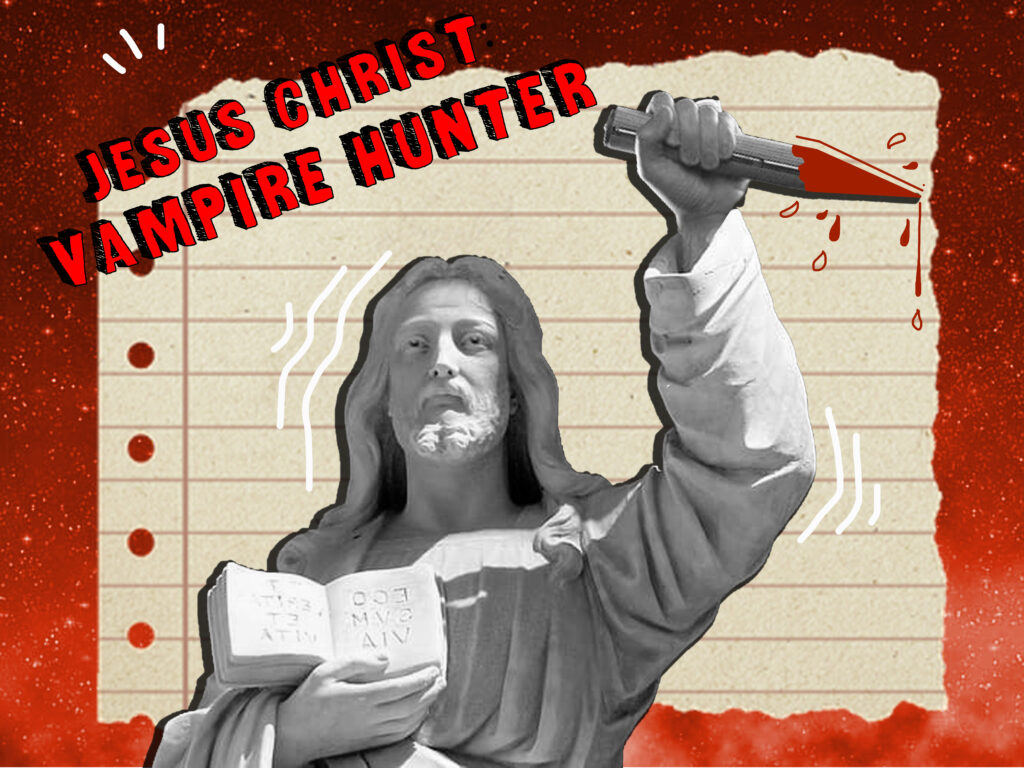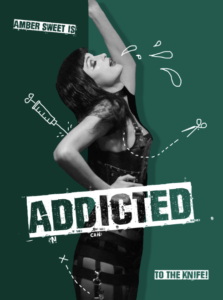
Halloween may be dead and gone, but it’s never the wrong season to watch a good old-fashioned horror film. Well, wait…can it really be referred to as a horror film? Or would it be more accurate to dub this a musical comedy? What about a queer romance? Maybe a religious drama, or medical thriller? Oh, wait, how about a martial arts or wrestling movie?
The truth is, the 2001 Canadian film “Jesus Christ: Vampire Hunter” defies genre, largely because it does not want to spend a second of its 90 minutes of screen time toeing the lines of convention. It flings tropes, plot twists and incongruous jokes around with the glee of a sugar-crazed toddler set free in a ball pit, romping wherever it pleases and trusting that the audience will hang on for the ride.
Let’s pull back and set the scene. Post-opening credits, the curtain rises on two priests, one (Eustace) dressed like Chadwick Boseman at the Met Gala, the other (Alban) sporting a silver-studded leather jacket and a mohawk spiked six inches high. The pair are speaking cryptically about plans to seek out “a man who can stop this unholy plague.” When Eustace tells him that “Arrangements have already been made”, Alban nods, climbs aboard a nearby Vespa and roars through the streets of Ottawa, soon pulling up to a sparkling lake. Hip-deep in its waters stands a man, instantly identifiable from his flowing robes, his equally flowing hair and — as the cherry on top — the woman he’s in the middle of baptizing. It’s Jesus Christ himself.
We don’t learn how Jesus has achieved this second coming, or how long he’s been at this Canadian lake or why, and we never will. All we learn is what the priests deem relevant to him: members of their congregation are disappearing, picked off by a cabal of vampires who are miraculously able to walk in daylight unharmed. They’ve appealed to the Vatican for assistance, but been refused due to the “lifestyle” of the women the vampires tend to target — as Jesus puts it, the victims are almost universally “ladies of Sappho.” Now, their best option and greatest hope is the Son of God.
Fortunately, Jesus seems to feel at ease in the modern world. He takes the Vespa back to town without a hitch, gets his hair cut and his ears pierced, and launches into song about how he’s here to save the folk of Ontario from the vampiric menace. The four-minute, dance-heavy musical number is underscored by what the subtitles dub “light classical music,” and it’s sadly uninspiring to listen to. Perhaps it’s fortunate that this is the only musical number in the movie, as though the writers preemptively exhausted their lyrical skills and the choreography budget and decided to quit while they were ahead.
The pace soon picks up, however; as Jesus walks the streets of Ottawa with his arms full of stakes, a vanful of sinister atheists pull up and announce their intent to throw down. Though dozens of atheists pour from the vehicle like it’s a clown car, each assailant appears to fall comatose after a single hit, allowing Jesus to dispatch them easily with a few martial arts moves. Stepping off the mound of their bodies, he heads back to Father Eustace’s apartment — where a camo-clad woman lies in wait for him with a gun in hand. But wait; she’s friendly! Her business card declares her “Mary Magnum,” available at 555-6969 or bigmags@vatican.com; she belongs to a clandestine, woman-centered branch of the church that’s been researching the vampire epidemic. She’s concluded that the ability to walk in daylight unharmed stems from the brilliant Doctor Praetorius, who’s been providing the bloodsuckers with human skin grafts, obtained from locally sourced lesbians. It’s up to her and Jesus to go investigate his lab.
At this point, we’re over a third of the way through the film, but much of the plot still has yet to develop, thanks to the film’s aforementioned tendency to run haywire with whatever happens in the moment. A few low-spoiler highlights from the rest of the film include: the use of entrails as nunchucks, the declaration that God loves lesbians because “they get so much done in a day,” the revelation that Jesus can duplicate his body and be multiple places at once (saved from being a deus ex machina only by the fact that it’s in no way relevant to the plot), Jesus being called upon to freestyle in a jazz club and failing miserably, and God himself, perhaps having forgotten to pay the Heavenly phone bill, offering Jesus advice through a plate of diner ice cream. No, they don’t make any more sense in context, but that’s half the fun.
All in all, “Jesus Christ: Vampire Hunter” is a rollicking good time. The jokes are varied and bizarre enough that they’ll never fail to startle a laugh out of you; the ever-shifting, endlessly original plot will keep you glued to the screen. Plus, the film is fairly respectful of its lesbian characters; two of them even find a happy ending together. True, their relationship gets zero character development, but neither does any other relationship in the film. And the trope of men “turning” lesbians straight is cheekily subverted when a woman previously seen making out with a female vampire announces that she’s bi before flying (literally) off into the sunset with a man. Though there are a few voyeuristic moments from male characters, and the soundtrack certainly lags in places, and if you get up to get a snack you may lose track of events entirely, “Jesus Christ: Vampire Hunter” remains a stellar modern comedy. It may not be an exemplar of any one film genre, but as an unabashed mishmash of the strangest, funniest parts of every style, it shines.


